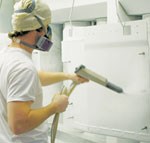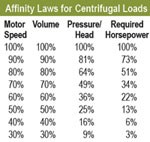9 Ways to Cut Costs in 2010
Reduce your energy consumption to increase profit
When it comes to cutting costs, there's something to be said for reviewing expenses, letting go of unnecessary staff and limiting discretionary e-xpenditures.
When it comes to cutting costs, there's something to be said for reviewing expenses, letting go of unnecessary staff and limiting discretionary e-xpenditures. Real cost reduction, however, is harder work.
It requires a close look at efficiencies, and a steadfast commitment to make changes or investments that will make the same product or provide the same level of service without sacrificing people or quality. But cutting operating costs is worth the effort when you consider that a savings of $100,000 through cost reductions is the equivalent of $2 million in sales at 5% net profit.
Featured Content
There are many opportunities available for effective cost reduction. A quick review of the items that contribute to the cost of coating includes a lot of costs that are fixed and will not change regardless of whether the system is running efficiently or poorly. The place to look for cost cutting is the variable costs. In most cases this means labor, materials and utilities.
1 Automate Processes
Automation or process changes can generate labor cost savings. Lean manufacturing principles stress removal of non-value-added labor and processes. A process can be analyzed to look for opportunities to improve and eliminate steps that will reduce labor. Common sense can also tell you there's unnecessary labor content in a process.
2 Use Materials Wisely
In many finishing shops, it's hard to impact the cost of materials. Customers specify the coatings to be applied, but finishers may be able to reduce material usage by improving transfer efficiency, reclaiming powder, and assuring they are not applying a coating that is thicker than necessary.
3 Make A Green Checklist
One aspect of your business that's likely ripe for assessment (and can have a huge impact on your bottom line) is your usage of energy and utilities. Coatings systems use electricity to drive motors; natural gas to heat buildings, ovens and washer burners; water in chemical cleaning and pretreatment systems; and compressed air for a variety of tasks. Evaluation of the use of these areas may reveal several major opportunities for cost reduction.
4 Consider High-Efficiency Motors

.jpg;maxWidth=600)
However, high-efficiency motors can provide savings when compared with standard motors. In addition to using less power, the payback on high-efficiency motors can often be improved with incentives from power companies. Many high-efficiency motors also have higher power factors than the standard motors they replace. For facilities that have power factor penalty charges, carefully choosing a high-efficiency motor that also has a higher power factor can result in electric cost savings that will improve the payback time of high-efficiency motors, which are more costly than standard models.
Another important consideration is load factor. Motors are typically rated with some additional capacity for short, temporary overload conditions. If a motor is run at the very high end of its capacity all the time, it will overheat and its service life will be shortened. For this reason it is critical to be sure a motor is large enough but not too large—motors running at 60% of load or better have high power factors and deliver near-peak efficiency. When motors run at lower than 60% of load, power factor declines and so does efficiency.

Sizing a motor that is just big enough for the task will mean that it must run near its maximum load. Sizing a motor larger than the maximum will allow it to run with less power use. If electricity costs $0.08/kWh, a 100-hp motor that is run at 100% speed, 12 hr/day, 360 days a year will cost $27,139 to operate. The same motor run at 60% speed will cost $5,970 a year.
Some system fan motors or pump motors are routinely adjusted to save electricity. Motors can be designed to be two-speed or equipped with variable-speed drives (VSDs), but the best way to control fan volume is with a variable-frequency drive (VFD). A VFD controls the rotational speed of the motor by adjusting the frequency of the power supply. It will add capital cost to the equipment. but it could very easily pay for itself in a short time.
The most obvious candidate for a VFD is a spray booth. In a powder booth the VFD can be used to increase fan volume during clean-up and decrease it during spray operation. Cleaning is more effective if the fan pulls a little harder because it helps to keep powder in the booth. During operation, less air is needed so electricity is saved. The fan can be adjusted to suit a particular operation.
A VFD is even more valuable in liquid spray systems. Precise adjustment allows the booth to move just enough air to maintain a clean and safe environment. Air volume can be low when filters are clean, then gradually increased as filters load with paint solids. This approach uses less electricity and exhausts less air. Less exhaust air means that less make-up air is needed, so an added benefit is reduced heating or cooling costs.
VFDs can also be used to accelerate oven purge cycles. The fan runs at a faster speed during purge and then slows to the normal volume when purging is complete.
Several other factors can impact motor efficiency. These include supply voltage, phase imbalances, location of capacitors and correct installation and maintenance. Motor supply voltage should be maintained with a maximum deviation of 5% from the nameplate value. Minimizing phase imbalance within 1% will avoid motor de-rating, and installation of capacitors as close to the motor as possible will maintain high power factor.
Adopt a proper motor maintenance strategy for motors. Control ambient temperature to maximize insulation life and motor reliability, and locate motors in well-ventilated areas. Keep them clean and lubricate according to manufacturers' specifications using high-quality greases or oils to prevent contamination with dirt or water.
Optimize transmission efficiency by assuring proper installation and maintenance of shafts, belts, chains, and gears. When replacement becomes necessary, install energy-efficient units. Always have burnt-out motors rewound by a qualified expert.
5 Prevent Air Compressor Leaks
Every manufacturer has at least one air compressor. Compressed air is used to power tools throughout the plant, and it is also an important component of the coating application process. It powers the back-pulse mechanism in a powder booth to clean the cartridges and it is a key component in the delivery of coatings through a spray gun.
Compressed air is also one of the most inefficient uses of energy in most plants.
One horsepower of work from an air motor requires a flow of approximately 30 scfm inlet air at 90 psig. That air flow requires 6-7 hp at the compressor shaft, assuming a 90% efficient motor. So 7-8 hp of electrical power is needed to deliver 1 hp of compressed air to the plant floor. Net efficiency is less than 12.5% of the input energy.
This would be bad enough in itself, but many plants also waste a lot of the air that is generated through leakage. In a typical plant, the air lost through leaks is around 10% of the total air produced. A cumulative leak of 1/16 inch is worth around $56 a month. A cumulative leak of 1/2 inch is worth around $3,500/month.
The good news is, leaks are not a necessary part of manufacturing. High-quality fittings and valves can be used to prevent or minimize leaks. Hose connections with a spring guard can prevent leaks at flex points, and regular inspection and repair of leaks can save substantial energy.
A high-quality air system can save 20-50% in total electric use. Systems with multiple compressors should use a controller to manage compressor operation and air delivery.
Network controls can use compressor microprocessors linked together to form a chain of communication that governs decisions to stop/start, load/unload, modulate, and vary displacement and speed.
System master controls coordinate all the functions necessary to optimize compressed air as a utility. System master controls have many functional capabilities, including the ability to monitor and control all components in the system, as well as trending data, to enhance maintenance functions and minimize costs of operation.
6 Reduce Water And Chemical Consumption
So far this article has focused mainly on ways to reduce electricity usage, but finishing shops also use water and natural gas.
A washer consumes both water and chemicals. Standard counter-flow measures and lower-temperature cleaning and pretreatment products should be used in every facility.
In addition to these widely accepted methods of reducing water and chemical consumption, it is a good idea to review oil removal, filtration, and pre-cleaning as potential ways to extend the life of cleaning solutions and reduce waste.
Gas is consumed by burners in ovens and the washer used in a coating system. Consumption is related to load, exhaust, process temperature, insulation and maintenance. The load factor is based on production, and a certain exhaust volume is required for a given coating and coating volume.
7 Use Lower-Cure Coatings
A 100°F decrease in a typical convection oven will reduce gas usage by 35-40%
8 Use Lower-Temp Cleaners or Conversion Coatings
A low-temperature cleaner with an ambient conversion coating stage can save 65-75% of natural gas usage in a washer.
9 Improve Your Insulation
At 400°F, an increase of 2 inches of insulation will save 11% on oven gas use.



















